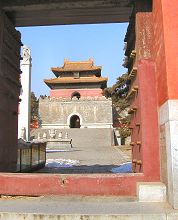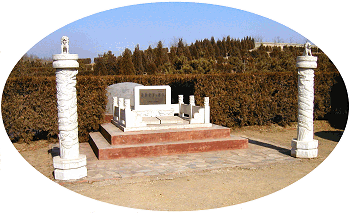


Most rulers of a given dynasty would typically be buried in close vicinity of each other in a joint imperial tomb site. Not so for the Qing dynasty.
The first two Qing emperors, Nu'erhachi (1559-1626) and Huangtaiji (1592-1643), are buried in Shenyang, because this was Qing's imperial capital during their reign. Their tomb sites, nowadays called the Northern Tomb and the Eastern Tomb, are both accessible to the public. A pictorial journey of these two tombs can be found here.
 In
1644, Qing enthroned itself as the new Chinese dynasty ruling all of China,
replacing the former Ming dynasty. Qing moved its capital to Beijing with
imperial palace in The Forbidden City. As a further consequence, Qing now used
the vicinity of Beijing as future burial grounds for deceased emperors, their
wives and concubines. The site is located some 125 kilometers northeast of
Beijing and is nowadays referred to as the
Eastern Qing Tombs. You can take a pictorial journey of the site
here.
In
1644, Qing enthroned itself as the new Chinese dynasty ruling all of China,
replacing the former Ming dynasty. Qing moved its capital to Beijing with
imperial palace in The Forbidden City. As a further consequence, Qing now used
the vicinity of Beijing as future burial grounds for deceased emperors, their
wives and concubines. The site is located some 125 kilometers northeast of
Beijing and is nowadays referred to as the
Eastern Qing Tombs. You can take a pictorial journey of the site
here.
And so it remained all well and proper until the fifth Qing emperor,
Yongzheng (1678-1735), decided to inaugurate a new burial site for himself;
-still near
 Beijing
but hundreds of kilometers west of the original Qing tomb site. From that time
and onwards Qing emperors were alternately buried in the eastern- or western
Qing tombs. To find out why emperor Yongzheng broke with all tradition and to
see pictures and stories of the Western Qing
Tombs click here.
Beijing
but hundreds of kilometers west of the original Qing tomb site. From that time
and onwards Qing emperors were alternately buried in the eastern- or western
Qing tombs. To find out why emperor Yongzheng broke with all tradition and to
see pictures and stories of the Western Qing
Tombs click here.
 The
last emperor, Aisin Gioro Puyi (1905-1967), who was forced to abdicate to the
Republic in 1911, was originally buried in a common grave site. In 1980 his
remains were moved to a modest tomb in a private grave site close to the Western
Qing Tombs where his grandfather was interred.
Puyi's tomb is (deliberately?) not well marked, but you find my pictures
from it here.
The
last emperor, Aisin Gioro Puyi (1905-1967), who was forced to abdicate to the
Republic in 1911, was originally buried in a common grave site. In 1980 his
remains were moved to a modest tomb in a private grave site close to the Western
Qing Tombs where his grandfather was interred.
Puyi's tomb is (deliberately?) not well marked, but you find my pictures
from it here.
In short, you have to journey to four different locations to see all Qing tombs. And they are well worth it in my opinion. If you don't have the time to do so or if you feel you need some inspiration first, then you can visit them on these pages.